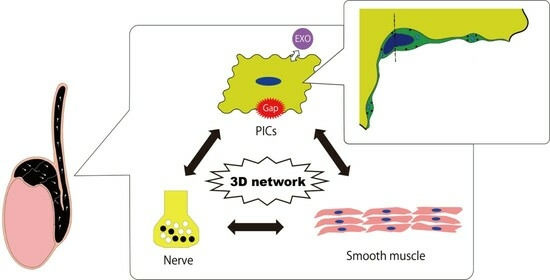Insights on Platelet-Derived Growth Factor Receptor α-Positive Interstitial Cells in the Male Reproductive Tract
Abstract
:1. Introduction
2. Interstitial Cells Involved in Smooth Muscle Movement
3. Immunohistological Features of PICs
4. Morphological Features of PICs
5. Functional Features of PICs
6. Smooth Muscle Movement in Seminiferous Tubules
7. PICs in Seminiferous Tubules
8. Smooth Muscle Movement in Epididymal Ducts
9. PICs in Epididymis
10. Smooth Muscle Movement in the Vas Deferens
11. PICs in Vas Deferens
12. Conclusions
Author Contributions
Funding
Conflicts of Interest
References
- Babakhanzadeh, E.; Nazari, M.; Ghasemifar, S.; Khodadadian, A. Some of the Factors Involved in Male Infertility: A Prospective Review. Int. J. Gen. Med. 2020, 13, 29–41. [Google Scholar] [CrossRef]
- Irvine, D.S. Epidemiology and aetiology of male infertility. Hum. Reprod. 1998, 13, 33–44. [Google Scholar] [CrossRef] [PubMed]
- Mahat, R.K.; Arora, M.; Bhale, D.V.; Holkar, S.; Kumar, S.; Yadav, T. Risk Factors and Causes of Male Infertility-A Review. Biochem. Anal. Biochem. 2016, 5, 1–5. [Google Scholar]
- Luconi, M.; Forti, G.; Baldi, E. Pathophysiology of sperm motility. Front. Biosci. Landmark 2006, 11, 1433–1447. [Google Scholar] [CrossRef] [PubMed]
- Ellis, L.C.; Farr, G.C.; Tesi, R.J. Contractility of seminiferous tubules as related to sperm transport in the male. Arch. Androl. 1981, 6, 283–294. [Google Scholar] [CrossRef] [PubMed]
- Soler, C.; Yeung, C.H.; Cooper, T.G. Development of sperm motility patterns in the murine epididymis. Int. J. Androl. 1994, 17, 271–278. [Google Scholar] [CrossRef] [PubMed]
- Axnér, E.; Linde-Forsberg, C.; Einarsson, S. Morphology and motility of spermatozoa from different regions of the epididymal duct in the domestic cat. Theriogenology 1999, 52, 767–778. [Google Scholar] [CrossRef] [PubMed]
- Yeung, C.-H.; Cooper, T.G. Acquisition and Development of Sperm Motility Upon Maturation in the Epididymis. In The Epididymis: From Molecules to Clinical Practice: A Comprehensive Survey of the Efferent Ducts, the Epididymis and the Vas Deferens; Springer: Cham, Switzerland, 2002; pp. 417–434. [Google Scholar]
- Fleck, D.; Kenzler, L.; Mundt, N.; Strauch, M.; Uesaka, N.; Moosmann, R.; Bruentgens, F.; Missel, A.; Mayerhofer, A.; Merhof, D.; et al. ATP activation of peritubular cells drives testicular sperm transport. Elife 2021, 10, e62885. [Google Scholar] [CrossRef]
- Elfgen, V.; Mietens, A.; Mewe, M.; Hau, T.; Middendorff, R. Contractility of the epididymal duct: Function, regulation and potential drug effects. Reproduction 2018, 156, R125–R141. [Google Scholar] [CrossRef]
- Koslov, D.S.; Andersson, K.E. Physiological and pharmacological aspects of the vas deferens-an update. Front. Pharmacol. 2013, 4, 101. [Google Scholar] [CrossRef]
- Klinge, E.; Sjöstrand, N. Smooth muscle of the male reproductive tract. In Pharmacology of Smooth Muscle; Springer: Berlin/Heidelberg, Germany, 1994; pp. 533–573. [Google Scholar]
- Courtois, F.; Carrier, S.; Charvier, K.; Guertin, P.A.; Journel, N.M. The control of male sexual responses. Curr. Pharm. Des. 2013, 19, 4341–4356. [Google Scholar] [CrossRef]
- Vanderwinden, J.-M. Role of Interstitial Cells of Cajal and their relationship with the enteric nervous system. Eur. J. Morphol. 1999, 37, 250–256. [Google Scholar] [CrossRef]
- Hirst, G.D.; Ward, S.M. Interstitial cells: Involvement in rhythmicity and neural control of gut smooth muscle. J. Physiol. 2003, 550, 337–346. [Google Scholar] [CrossRef]
- Brading, A.F.; McCloskey, K.D. Mechanisms of Disease: Specialized interstitial cells of the urinary tract—An assessment of current knowledge. Nat. Clin. Pract. Urol. 2005, 2, 546–554. [Google Scholar] [CrossRef]
- Hashitani, H. Interaction between interstitial cells and smooth muscles in the lower urinary tract and penis. J. Physiol. 2006, 576, 707–714. [Google Scholar] [CrossRef]
- Sanders, K.M.; Ward, S.M.; Koh, S.D. Interstitial cells: Regulators of smooth muscle function. Physiol. Rev. 2014, 94, 859–907. [Google Scholar] [CrossRef]
- Heinrich, A.; DeFalco, T. Essential roles of interstitial cells in testicular development and function. Andrology 2020, 8, 903–914. [Google Scholar] [CrossRef]
- Sanders, K.M.; Ward, S.M. Interstitial cells of Cajal: A new perspective on smooth muscle function. J. Physiol. 2006, 576, 721–726. [Google Scholar] [CrossRef]
- Ward, S.M.; Sanders, K.M.; Hirst, G.D. Role of interstitial cells of Cajal in neural control of gastrointestinal smooth muscles. Neurogastroenterol. Motil. 2004, 16, 112–117. [Google Scholar] [CrossRef]
- Koh, B.H.; Roy, R.; Hollywood, M.A.; Thornbury, K.D.; McHale, N.G.; Sergeant, G.P.; Hatton, W.J.; Ward, S.M.; Sanders, K.M.; Koh, S.D. Platelet-derived growth factor receptor-α cells in mouse urinary bladder: A new class of interstitial cells. J. Cell Mol. Med. 2012, 16, 691–700. [Google Scholar] [CrossRef]
- Rumessen, J.J.; Vanderwinden, J.M. Interstitial cells in the musculature of the gastrointestinal tract: Cajal and beyond. Int. Rev. Cytol. 2003, 229, 115–208. [Google Scholar]
- Blair, P.J.; Rhee, P.L.; Sanders, K.M.; Ward, S.M. The significance of interstitial cells in neurogastroenterology. J. Neurogastroenterol. Motil. 2014, 20, 294–317. [Google Scholar] [CrossRef]
- Daniel, E.; Berezin, I. Interstitial cells of Cajal: Are they major players in control of gastrointestinal motility? Neurogastroenterol. Motil. 1992, 4, 1–24. [Google Scholar] [CrossRef]
- Burns, A.J.; Herbert, T.M.; Ward, S.M.; Sanders, K.M. Interstitial cells of Cajal in the guinea-pig gastrointestinal tract as revealed by c-Kit immunohistochemistry. Cell Tissue Res. 1997, 290, 11–20. [Google Scholar] [CrossRef]
- Hudson, N.P.; Pearson, G.T.; Kitamura, N.; Mayhew, I.G. An immunohistochemical study of interstitial cells of Cajal (ICC) in the equine gastrointestinal tract. Res. Vet. Sci. 1999, 66, 265–271. [Google Scholar] [CrossRef]
- Horowitz, B.; Ward, S.M.; Sanders, K.M. Cellular and molecular basis for electrical rhythmicity in gastrointestinal muscles. Annu. Rev. Physiol. 1999, 61, 19–43. [Google Scholar] [CrossRef]
- Lee, J.C.; Thuneberg, L.; Berezin, I.; Huizinga, J.D. Generation of slow waves in membrane potential is an intrinsic property of interstitial cells of Cajal. Am. J. Physiol. 1999, 277, G409-23. [Google Scholar] [CrossRef]
- Sanders, K.M.; Koh, S.D.; Ward, S.M. Interstitial cells of cajal as pacemakers in the gastrointestinal tract. Annu. Rev. Physiol. 2006, 68, 307–343. [Google Scholar] [CrossRef]
- Barajas-Lopez, C.; Berezin, I.; Daniel, E.E.; Huizinga, J.D. Pacemaker activity recorded in interstitial cells of Cajal of the gastrointestinal tract. Am. J. Physiol. 1989, 257, C830–C835. [Google Scholar] [CrossRef] [PubMed]
- Torihashi, S.; Fujimoto, T.; Trost, C.; Nakayama, S. Calcium oscillation linked to pacemaking of interstitial cells of Cajal: Requirement of calcium influx and localization of TRP4 in caveolae. J. Biol. Chem. 2002, 277, 19191–19197. [Google Scholar] [CrossRef] [PubMed]
- Sanders, K.M.; Koh, S.D.; Ördög, T.; Ward, S.M. Ionic conductances involved in generation and propagation of electrical slow waves in phasic gastrointestinal muscles. Neurogastroenterol. Motil. 2004, 16, 100–105. [Google Scholar] [CrossRef]
- Evans, E.D.; Mangel, A.W. Depolarization-stimulated contractility of gastrointestinal smooth muscle in calcium-free solution: A review. ISRN Gastroenterol. 2011, 2011, 692528. [Google Scholar] [CrossRef] [PubMed]
- Ward, S.M.; Baker, S.A.; De Faoite, A.; Sanders, K.M. Propagation of slow waves requires IP3 receptors and mitochondrial Ca2+ uptake in canine colonic muscles. J Physiol 2003, 549, 207–218. [Google Scholar] [CrossRef] [PubMed]
- Rømert, P.; Mikkelsen, H.B. c-kit immunoreactive interstitial cells of Cajal in the human small and large intestine. Histochem. Cell Biol. 1998, 109, 195–202. [Google Scholar] [CrossRef] [PubMed]
- Gevaert, T.; Ridder, D.D.; Vanstreels, E.; Daelemans, D.; Everaerts, W.; Aa, F.V.D.; Pintelon, I.; Timmermans, J.P.; Roskams, T.; Steiner, C.; et al. The stem cell growth factor receptor KIT is not expressed on interstitial cells in bladder. J. Cell Mol. Med. 2017, 21, 1206–1216. [Google Scholar] [CrossRef]
- Clayton, D.R.; Ruiz, W.G.; Dalghi, M.G.; Montalbetti, N.; Carattino, M.D.; Apodaca, G. Studies of ultrastructure, gene expression, and marker analysis reveal that mouse bladder PDGFRA. Am. J. Physiol. Renal. Physiol. 2022, 323, F299–F321. [Google Scholar] [CrossRef]
- Andrae, J.; Gallini, R.; Betsholtz, C. Role of platelet-derived growth factors in physiology and medicine. Genes Dev. 2008, 22, 1276–1312. [Google Scholar] [CrossRef]
- Bergsten, E.; Uutela, M.; Li, X.; Pietras, K.; Östman, A.; Heldin, C.H.; Alitalo, K.; Eriksson, U. PDGF-D is a specific, protease-activated ligand for the PDGF beta-receptor. Nat. Cell Biol. 2001, 3, 512–516. [Google Scholar] [CrossRef] [PubMed]
- Fredriksson, L.; Li, H.; Eriksson, U. The PDGF family: Four gene products form five dimeric isoforms. Cytokine Growth Factor Rev. 2004, 15, 197–204. [Google Scholar] [CrossRef]
- Hoch, R.V.; Soriano, P. Roles of PDGF in animal development. Development 2003, 130, 4769–4784. [Google Scholar] [CrossRef]
- Iino, S.; Horiguchi, K.; Horiguchi, S.; Nojyo, Y. c-Kit-negative fibroblast-like cells express platelet-derived growth factor receptor alpha in the murine gastrointestinal musculature. Histochem. Cell Biol. 2009, 131, 691–702. [Google Scholar] [CrossRef]
- Monaghan, K.P.; Johnston, L.; McCloskey, K.D. Identification of PDGFRα positive populations of interstitial cells in human and guinea pig bladders. J. Urol. 2012, 188, 639–647. [Google Scholar] [CrossRef]
- Gevaert, T.; Vanstreels, E.; Daelemans, D.; Franken, J.; Van Der Aa, F.; Roskams, T.; De Ridder, D. Identification of different phenotypes of interstitial cells in the upper and deep lamina propria of the human bladder dome. J. Urol. 2014, 192, 1555–1563. [Google Scholar] [CrossRef]
- Lee, H.; Koh, B.H.; Peri, L.E.; Sanders, K.M.; Koh, S.D. Functional expression of SK channels in murine detrusor PDGFR+ cells. J. Physiol. 2013, 591, 503–513. [Google Scholar] [CrossRef]
- Kurahashi, M.; Mutafova-Yambolieva, V.; Koh, S.D.; Sanders, K.M. Platelet-derived growth factor receptor-α-positive cells and not smooth muscle cells mediate purinergic hyperpolarization in murine colonic muscles. Am. J. Physiol. Cell Physiol. 2014, 307, C561-70. [Google Scholar] [CrossRef]
- Horiguchi, K.; Komuro, T. Ultrastructural observations of fibroblast-like cells forming gap junctions in the W/W(nu) mouse small intestine. J. Auton. Nerv. Syst. 2000, 80, 142–147. [Google Scholar] [CrossRef]
- Mantani, Y.; Haruta, T.; Nishida, M.; Yokoyama, T.; Hoshi, N.; Kitagawa, H. Three-dimensional analysis of fibroblast-like cells in the lamina propria of the rat ileum using serial block-face scanning electron microscopy. J. Vet. Med. Sci. 2019, 81, 454–465. [Google Scholar] [CrossRef]
- Schneider, P.; Meier, M.; Wepf, R.; Müller, R. Serial FIB/SEM imaging for quantitative 3D assessment of the osteocyte lacuno-canalicular network. Bone 2011, 49, 304–311. [Google Scholar] [CrossRef]
- Guérin, C.J.; Kremer, A.; Borghgraef, P.; Shih, A.Y.; Lippens, S. Combining serial block face and focused ion beam scanning electron microscopy for 3D studies of rare events. Methods Cell Biol. 2019, 152, 87–101. [Google Scholar]
- Smith, D.; Starborg, T. Serial block face scanning electron microscopy in cell biology: Applications and technology. Tissue Cell 2019, 57, 111–122. [Google Scholar] [CrossRef]
- Takeya, M.; Hashitani, H.; Hayashi, T.; Higashi, R.; Nakamura, K.I.; Takano, M. Role of mucosa in generating spontaneous activity in the guinea pig seminal vesicle. J. Physiol. 2017, 595, 4803–4821. [Google Scholar] [CrossRef]
- Neuhaus, J.; Schröppel, B.; Dass, M.; Zimmermann, H.; Wolburg, H.; Fallier-Becker, P.; Gevaert, T.; Burkhardt, C.J.; Do, H.M.; Stolzenburg, J.U. 3D-electron microscopic characterization of interstitial cells in the human bladder upper lamina propria. Neurourol. Urodyn. 2018, 37, 89–98. [Google Scholar] [CrossRef]
- Stanfield, P.R.; Nakajima, Y.; Yamaguchi, K. Substance P raises neuronal membrane excitability by reducing inward rectification. Nature 1985, 315, 498–501. [Google Scholar] [CrossRef]
- Benham, C.D.; Bolton, T.B.; Lang, R.J. Acetylcholine activates an inward current in single mammalian smooth muscle cells. Nature 1985, 316, 345–347. [Google Scholar] [CrossRef]
- Wiesenfeld-Hallin, Z. Substance P and somatostatin modulate spinal cord excitability via physiologically different sensory pathways. Brain Res. 1986, 372, 172–175. [Google Scholar] [CrossRef]
- Faussone-Pellegrini, M.S. Relationships between neurokinin receptor-expressing interstitial cells of Cajal and tachykininergic nerves in the gut. J. Cell. Mol. Med. 2006, 10, 20–32. [Google Scholar] [CrossRef]
- Zhu, M.H.; Sung, I.K.; Zheng, H.; Sung, T.S.; Britton, F.C.; O’Driscoll, K.; Koh, S.D.; Sanders, K.M. Muscarinic activation of Ca2+-activated Cl- current in interstitial cells of Cajal. J. Physiol. 2011, 589, 4565–4582. [Google Scholar] [CrossRef]
- Dickson, E.J.; Falkenburger, B.H.; Hille, B. Quantitative properties and receptor reserve of the IP(3) and calcium branch of G(q)-coupled receptor signaling. J. Gen. Physiol. 2013, 141, 521–535. [Google Scholar] [CrossRef]
- Hisatsune, C.; Nakamura, K.; Kuroda, Y.; Nakamura, T.; Mikoshiba, K. Amplification of Ca2+ signaling by diacylglycerol-mediated inositol 1,4,5-trisphosphate production. J. Biol. Chem. 2005, 280, 11723–11730. [Google Scholar] [CrossRef]
- Thillaiappan, N.B.; Chakraborty, P.; Hasan, G.; Taylor, C.W. IP3 receptors and Ca2+ entry. Biochim. Biophys. Acta Mol. Cell Res. 2019, 1866, 1092–1100. [Google Scholar] [CrossRef]
- Jin, X.; Shah, S.; Liu, Y.; Zhang, H.; Lees, M.; Fu, Z.; Lippiat, J.D.; Beech, D.J.; Sivaprasadarao, A.; Baldwin, S.A.; et al. Activation of the Cl- channel ANO1 by localized calcium signals in nociceptive sensory neurons requires coupling with the IP3 receptor. Sci. Signal. 2013, 6, ra73. [Google Scholar] [CrossRef]
- Gerevich, Z.; Borvendeg, S.J.; Schröder, W.; Franke, H.; Wirkner, K.; Nörenberg, W.; Fürst, S.; Gillen, C.; Illes, P. Inhibition of N-type voltage-activated calcium channels in rat dorsal root ganglion neurons by P2Y receptors is a possible mechanism of ADP-induced analgesia. J. Neurosci. 2004, 24, 797–807. [Google Scholar] [CrossRef]
- Mutafova-Yambolieva, V.N.; Hwang, S.J.; Hao, X.; Chen, H.; Zhu, M.X.; Wood, J.D.; Ward, S.M.; Sanders, K.M. Beta-nicotinamide adenine dinucleotide is an inhibitory neurotransmitter in visceral smooth muscle. Proc. Natl. Acad. Sci. USA 2007, 104, 16359–16364. [Google Scholar] [CrossRef]
- Sperlágh, B.; Heinrich, A.; Csölle, C. P2 receptor-mediated modulation of neurotransmitter release-an update. Purinergic Signal 2007, 3, 269–284. [Google Scholar] [CrossRef]
- Erb, L.; Weisman, G.A. Coupling of P2Y receptors to G proteins and other signaling pathways. Wiley Interdiscip. Rev. Membr. Transp. Signal. 2012, 1, 789–803. [Google Scholar] [CrossRef]
- Lee, H.; Koh, B.H.; Peri, L.E.; Sanders, K.M.; Koh, S.D. Purinergic inhibitory regulation of murine detrusor muscles mediated by PDGFRα+ interstitial cells. J. Physiol. 2014, 592, 1283–1293. [Google Scholar] [CrossRef]
- Kurahashi, M.; Baker, S.A.; Kito, Y.; Bartlett, A.; Hara, M.; Takeyama, H.; Hashitani, H.; Sanders, K.M. PDGFRα+ Interstitial Cells are Effector Cells of PACAP Signaling in Mouse and Human Colon. Cell Mol. Gastroenterol. Hepatol. 2022, 14, 357–373. [Google Scholar] [CrossRef]
- Jiménez, M. Platelet-derived growth factor receptor-α-positive cells: New players in nerve-mediated purinergic responses in the colon. J. Physiol. 2015, 593, 1765–1766. [Google Scholar] [CrossRef]
- Setchell, B.P.; Davies, R.V.; Gladwell, R.T.; Hinton, B.T.; Main, S.J.; Pilsworth, L.; Waites, G.M.H. The movement of fluid in the seminiferous tubules and rete testis. Annal. Biol. Anim. Biochim. Biophys. 1978, 18, 623–632. [Google Scholar] [CrossRef]
- Worley, R.T.S.; Leendertz, J.A. A videomicrographic low-frequency movement analyser (VLMA) and perifusion chamber for recording and analysis of the physical behaviour of seminiferous tubules and other contractile tissues in vitro. J. Microsc. 1988, 151, 61–69. [Google Scholar] [CrossRef]
- Clermont, Y. Contractile elements in the limiting membrane of the seminiferous tubules of the rat. Exp. Cell Res. 1958, 15, 438–440. [Google Scholar] [CrossRef]
- Ross, M.H. The fine structure and development of the peritubular contractile cell component in the seminiferous tubules of the mouse. Am. J. Anat. 1967, 121, 523–557. [Google Scholar] [CrossRef]
- Maekawa, M.; Kamimura, K.; Nagano, T. Peritubular myoid cells in the testis: Their structure and function. Arch. Histol. Cytol. 1996, 59, 1–13. [Google Scholar] [CrossRef]
- Losinno, A.D.; Morales, A.; Fernández, D.; Lopez, L.A. Peritubular myoid cells from rat seminiferous tubules contain actin and myosin filaments distributed in two independent layers. Biol. Reprod. 2012, 86, 150. [Google Scholar] [CrossRef]
- Pickering, B.T.; Birkett, S.D.; Guldenaar, S.E.; Nicholson, H.D.; Worley, R.T.; Yavachev, L. Oxytocin in the testis: What, where, and why? Ann. N. Y. Acad. Sci. 1989, 564, 198–209. [Google Scholar] [CrossRef]
- Worley, R.; Nicholson, H.D.; Pickering, B.T. Testicular oxytocin: An initiator of seminiferous tubule movement. Recent Prog. Cell. Endocrinol. Testis 1985, 205–212. [Google Scholar]
- Hargrove, J.; Seeley, R.; Ellis, L. Rabbit testicular contractions: Bimodal interaction of prostaglandin E1 with other agonists. Am. J. Physiol. Leg. Content 1975, 228, 810–814. [Google Scholar] [CrossRef]
- Filippini, A.; Tripiciano, A.; Palombi, F.; Teti, A.; Paniccia, R.; Stefanini, M.; Ziparo, E. Rat testicular myoid cells respond to endothelin: Characterization of binding and signal transduction pathway. Endocrinology 1993, 133, 1789–1796. [Google Scholar] [CrossRef]
- Gelain, D.P.; de Souza, L.F.; Bernard, E.A. Extracellular purines from cells of seminiferous tubules. Mol. Cell Biochem. 2003, 245, 1–9. [Google Scholar] [CrossRef]
- Marini, M.; Rosa, I.; Guasti, D.; Gacci, M.; Sgambati, E.; Ibba-Manneschi, L.; Manetti, M. Reappraising the microscopic anatomy of human testis: Identification of telocyte networks in the peritubular and intertubular stromal space. Sci. Rep. 2018, 8, 14780. [Google Scholar] [CrossRef]
- Pawlicki, P.; Hejmej, A.; Milon, A.; Lustofin, K.; Płachno, B.J.; Tworzydlo, W.; Gorowska-Wojtowicz, E.; Pawlicka, B.; Kotula-Balak, M.; Bilinska, B. Telocytes in the mouse testicular interstitium: Implications of G-protein-coupled estrogen receptor (GPER) and estrogen-related receptor (ERR) in the regulation of mouse testicular interstitial cells. Protoplasma 2019, 256, 393–408. [Google Scholar] [CrossRef]
- Liu, Y.; Liang, Y.; Wang, S.; Tarique, I.; Vistro, W.A.; Zhang, H.; Haseeb, A.; Gandahi, N.S.; Iqbal, A.; An, T.; et al. Identification and characterization of telocytes in rat testis. Aging 2019, 11, 5757–5768. [Google Scholar] [CrossRef]
- Yang, P.; Ahmad, N.; Hunag, Y.; Ullah, S.; Zhang, Q.; Waqas, Y.; Liu, Y.; Li, Q.; Hu, L.; Chen, Q. Telocytes: Novel interstitial cells present in the testis parenchyma of the Chinese soft-shelled turtle Pelodiscus sinensis. J. Cell Mol. Med. 2015, 19, 2888–2899. [Google Scholar] [CrossRef]
- Mietens, A.; Tasch, S.; Stammler, A.; Konrad, L.; Feuerstacke, C.; Middendorff, R. Time-lapse imaging as a tool to investigate contractility of the epididymal duct—Effects of cGMP signaling. PLoS ONE 2014, 9, e92603. [Google Scholar] [CrossRef]
- Robaire, B.; Hinton, B.T. The Epididymis. In Knobil and Neill’s Physiology of Reproduction, 4th ed.; Elsevier: New York, NY, USA, 2015; pp. 691–772. [Google Scholar]
- Muratori, G.; Contro, S. Observations on the movements of the canal of the epididymis. Boll. Soc. Ital. Biol. Sper. 1951, 27, 538–539. [Google Scholar]
- Knight, T.W. A qualitative study of factors affecting the contractions of the epididymis and ductus deferens of the ram. J. Reprod. Fertil. 1974, 40, 19–29. [Google Scholar] [CrossRef]
- Hib, J. Effects of autonomic drugs on epididymal contractions. Fertil. Steril. 1976, 27, 951–956. [Google Scholar] [CrossRef]
- Hib, J.; Caldeyro-Barcia, R. Neurohormonal control of epididymal contractions. Basic Life Sci. 1974, 4, 111–126. [Google Scholar]
- Markkula-Viitanen, M.; Nikkanen, V.; Talo, A. Electrical activity and intraluminal pressure of the cauda epididymidis of the rat. J. Reprod. Fertil. 1979, 57, 431–435. [Google Scholar] [CrossRef]
- Talo, A.; Jaakkola, U.M.; Markkula-Viitanen, M. Spontaneous electrical activity of the rat epididymis in vitro. J. Reprod. Fertil. 1979, 57, 423–429. [Google Scholar] [CrossRef]
- van de Velde, R.L.; Risley, P.L. The origin and development of smooth muscle and contractility in the ductus epididymidis of the rat. J. Embryol. Exp. Morphol. 1963, 11, 369–382. [Google Scholar] [CrossRef]
- Mitsui, R.; Hashitani, H.; Lang, R.J.; van Helden, D.F. Mechanisms underlying spontaneous phasic contractions and sympathetic control of smooth muscle in the rat caudal epididymis. Pflug. Arch. 2021, 473, 1925–1938. [Google Scholar] [CrossRef]
- Nouhouayi, Y.; Négulesco, I. Adrenergic innervation of the smooth muscle cells of the cauda epididymis of the mouse. Acta Anat. 1985, 121, 59–62. [Google Scholar] [CrossRef]
- Mewe, M.; Bauer, C.K.; Schwarz, J.R.; Middendorff, R. Mechanisms regulating spontaneous contractions in the bovine epididymal duct. Biol. Reprod. 2006, 75, 651–659. [Google Scholar] [CrossRef]
- Din-Udom, A.; Sujarit, S.; Pholpramool, C. Short-term effect of androgen deprivation on intraluminal pressure and contractility of the rat epididymis. J. Reprod. Fertil. 1985, 73, 405–410. [Google Scholar] [CrossRef]
- da Silva e Souza, M.C.; Gimeno, M.F.; Gimeno, A.L. Spontaneous and testosterone-induced motility of isolated guinea-pig cauda epididymis. Experientia 1974, 30, 1063–1065. [Google Scholar] [CrossRef]
- Fibbi, B.; Filippi, S.; Morelli, A.; Vignozzi, L.; Silvestrini, E.; Chavalmane, A.; De Vita, G.; Marini, M.; Gacci, M.; Manieri, C.; et al. Estrogens regulate humans and rabbit epididymal contractility through the RhoA/Rho-kinase pathway. J. Sex. Med. 2009, 6, 2173–2186. [Google Scholar] [CrossRef]
- Mewe, M.; Bauer, C.K.; Müller, D.; Middendorff, R. Regulation of spontaneous contractile activity in the bovine epididymal duct by cyclic guanosine 5′-monophosphate-dependent pathways. Endocrinology 2006, 147, 2051–2062. [Google Scholar] [CrossRef]
- Chuang, A.T.; Strauss, J.D.; Steers, W.D.; Murphy, R.A. cGMP mediates corpus cavernosum smooth muscle relaxation with altered cross-bridge function. Life Sci. 1998, 63, 185–194. [Google Scholar] [CrossRef]
- Hofmann, F.; Wegener, J.W. cGMP-dependent protein kinases (cGK). Methods Mol. Biol. 2013, 1020, 17–50. [Google Scholar]
- Shariatmadari, R.; Sipilä, P.; Vierula, M.; Törnquist, K.; Huhtaniemi, I.; Poutanen, M. Adenosine triphosphate induces Ca2+ signal in epithelial cells of the mouse caput epididymis through activation of P2X and P2Y purinergic receptors. Biol. Reprod. 2003, 68, 1185–1192. [Google Scholar] [CrossRef]
- Belleannée, C.; Da Silva, N.; Shum, W.W.; Brown, D.; Breton, S. Role of purinergic signaling pathways in V-ATPase recruitment to apical membrane of acidifying epididymal clear cells. Am. J. Physiol. Cell Physiol. 2010, 298, C817-30. [Google Scholar] [CrossRef]
- Hiroshige, T.; Uemura, K.I.; Hirashima, S.; Hino, K.; Togo, A.; Ohta, K.; Igawa, T.; Nakamura, K.I. Morphological analysis of interstitial cells in murine epididymis using light microscopy and transmission electron microscopy. Acta Histochem. 2021, 123, 151761. [Google Scholar] [CrossRef]
- Da Silva, N.; Smith, T.B. Exploring the role of mononuclear phagocytes in the epididymis. Asian J. Androl. 2015, 17, 591–596. [Google Scholar] [CrossRef]
- Breton, S.; Nair, A.V.; Battistone, M.A. Epithelial dynamics in the epididymis: Role in the maturation, protection, and storage of spermatozoa. Andrology 2019, 7, 631–643. [Google Scholar] [CrossRef]
- Leung, G.P.H.; Cheung, K.H.; Leung, C.T.; Tsang, M.W.; Wong, P.Y.D. Regulation of epididymal principal cell functions by basal cells: Role of transient receptor potential (Trp) proteins and cyclooxygenase-1 (COX-1). Mol. Cell Endocrinol. 2004, 216, 5–13. [Google Scholar] [CrossRef]
- Arrighi, S. Are the basal cells of the mammalian epididymis still an enigma? Reprod. Fertil. Dev. 2014, 26, 1061–1071. [Google Scholar] [CrossRef]
- Leong, S.K.; Singh, G. Innervation of the monkey vas deferens. J. Anat. 1990, 171, 93–104. [Google Scholar]
- Kaleczyc, J. Origin and neurochemical characteristics of nerve fibres supplying the mammalian vas deferens. Microsc. Res. Tech. 1998, 42, 409–422. [Google Scholar] [CrossRef]
- Dixon, J.S.; Jen, P.W.; Gosling, J.A. Structure and autonomic innervation of the human vas deferens: A review. Microsc. Re.s Tech. 1998, 42, 423–432. [Google Scholar] [CrossRef]
- Kihara, K.; Sato, K.; Oshima, H. Sympathetic efferent pathways projecting to the vas deferens. Microsc. Res. Tech. 1998, 42, 398–408. [Google Scholar] [CrossRef]
- McGrath, J.C. Adrenergic and ‘non-adrenergic’ components in the contractile response of the vas deferens to a single indirect stimulus. J. Physiol. 1978, 283, 23–39. [Google Scholar] [CrossRef]
- Sneddon, P.; Westfall, D.P. Pharmacological evidence that adenosine triphosphate and noradrenaline are co-transmitters in the guinea-pig vas deferens. J. Physiol. 1984, 347, 561–580. [Google Scholar] [CrossRef]
- Kishi, I.; Hata, F.; Takeuchi, T.; Ishii, T.; Yagasaki, O. Cooperation of ATP and norepinephrine in inducing contractile responses in guinea pig vas deferens. Jpn. J. Pharmacol. 1990, 54, 253–256. [Google Scholar] [CrossRef]
- Sneddon, P.; Machaly, M. Regional variation in purinergic and adrenergic responses in isolated vas deferens of rat, rabbit and guinea-pig. J. Auton. Pharmacol. 1992, 12, 421–428. [Google Scholar] [CrossRef]
- Shimodan, M.; Sunano, S. The initiation of phasic and tonic contraction by potassium and the effect of calcium, multivalent cations and Ca-antagonist on potassium contracture in guinea-pig vas deferens. Jpn. J. Physiol. 1981, 31, 15–27. [Google Scholar] [CrossRef]
- Stone, T.W. Differential blockade of ATP, noradrenaline and electrically evoked contractions of the rat vas deferens by nifedipine. Eur. J. Pharmacol. 1981, 74, 373–376. [Google Scholar] [CrossRef]
- Amobi, N.; Guillebaud, J.; Coker, C.; Mulvin, D.; Smith, I.C.H. Functional characterization of alpha1-adrenoceptor subtypes in longitudinal and circular muscle of human vas deferens. Eur. J. Pharmacol. 1999, 367, 291–298. [Google Scholar] [CrossRef]
- Amobi, N.I.; Guillebaud, J.; Smith, I.C. Perspective on the role of P2X-purinoceptor activation in human vas deferens contractility. Exp. Physiol. 2012, 97, 583–602. [Google Scholar] [CrossRef]
- Brain, K.L.; Jackson, V.M.; Trout, S.J.; Cunnane, T.C. Intermittent ATP release from nerve terminals elicits focal smooth muscle Ca2+ transients in mouse vas deferens. J. Physiol. 2002, 541, 849–862. [Google Scholar] [CrossRef]
- Brain, K.L.; Cuprian, A.M.; Williams, D.J.; Cunnane, T.C. The sources and sequestration of Ca(2+) contributing to neuroeffector Ca(2+) transients in the mouse vas deferens. J. Physiol. 2003, 553, 627–635. [Google Scholar] [CrossRef]
- Ohi, Y.; Yamamura, H.; Nagano, N.; Ohya, S.; Muraki, K.; Watanabe, M.; Imaizumi, Y. Local Ca(2+) transients and distribution of BK channels and ryanodine receptors in smooth muscle cells of guinea-pig vas deferens and urinary bladder. J. Physiol. 2001, 534, 313–326. [Google Scholar] [CrossRef]
- White, C.; McGeown, J.G. Inositol 1,4,5-trisphosphate receptors modulate Ca2+ sparks and Ca2+ store content in vas deferens myocytes. Am. J. Physiol. Cell Physiol. 2003, 285, C195–204. [Google Scholar] [CrossRef]
- Büyükafşar, K.; Levent, A.; Ark, M. Expression of Rho-kinase and its functional role in the contractile activity of the mouse vas deferens. Br. J. Pharmacol. 2003, 140, 743–749. [Google Scholar] [CrossRef]
- Mulryan, K.; Gitterman, D.P.; Lewis, C.J.; Vial, C.; Leckie, B.J.; Cobb, A.L.; Brown, J.E.; Conley, E.C.; Buell, G.; Pritchard, C.A.; et al. Reduced vas deferens contraction and male infertility in mice lacking P2X1 receptors. Nature 2000, 403, 86–89. [Google Scholar] [CrossRef]
- Hiroshige, T.; Uemura, K.I.; Hirashima, S.; Hino, K.; Togo, A.; Ohta, K.; Igawa, T.; Nakamura, K.I. Identification of PDGFRα-positive interstitial cells in the distal segment of the murine vas deferens. Sci. Rep. 2021, 11, 7553. [Google Scholar] [CrossRef]
- Hiroshige, T.; Uemura, K.I.; Hirashima, S.; Hino, K.; Togo, A.; Ohta, K.; Igawa, T.; Nakamura, K.I. Three-Dimensional Analysis of Interstitial Cells in the Smooth Muscle Layer of Murine Vas Deferens Using Confocal Laser Scanning Microscopy and FIB/SEM. Microsc. Microanal. 2022, 28, 1–9. [Google Scholar] [CrossRef]
- Hiroshige, T.; Uemura, K.I.; Hirashima, S.; Togo, A.; Ohta, K.; Nakamura, K.I.; Igawa, T. Three-dimensional analysis of interstitial cells in the lamina propria of the murine vas deferens by confocal laser scanning microscopy and FIB/SEM. Sci. Rep. 2022, 12, 9484. [Google Scholar] [CrossRef]
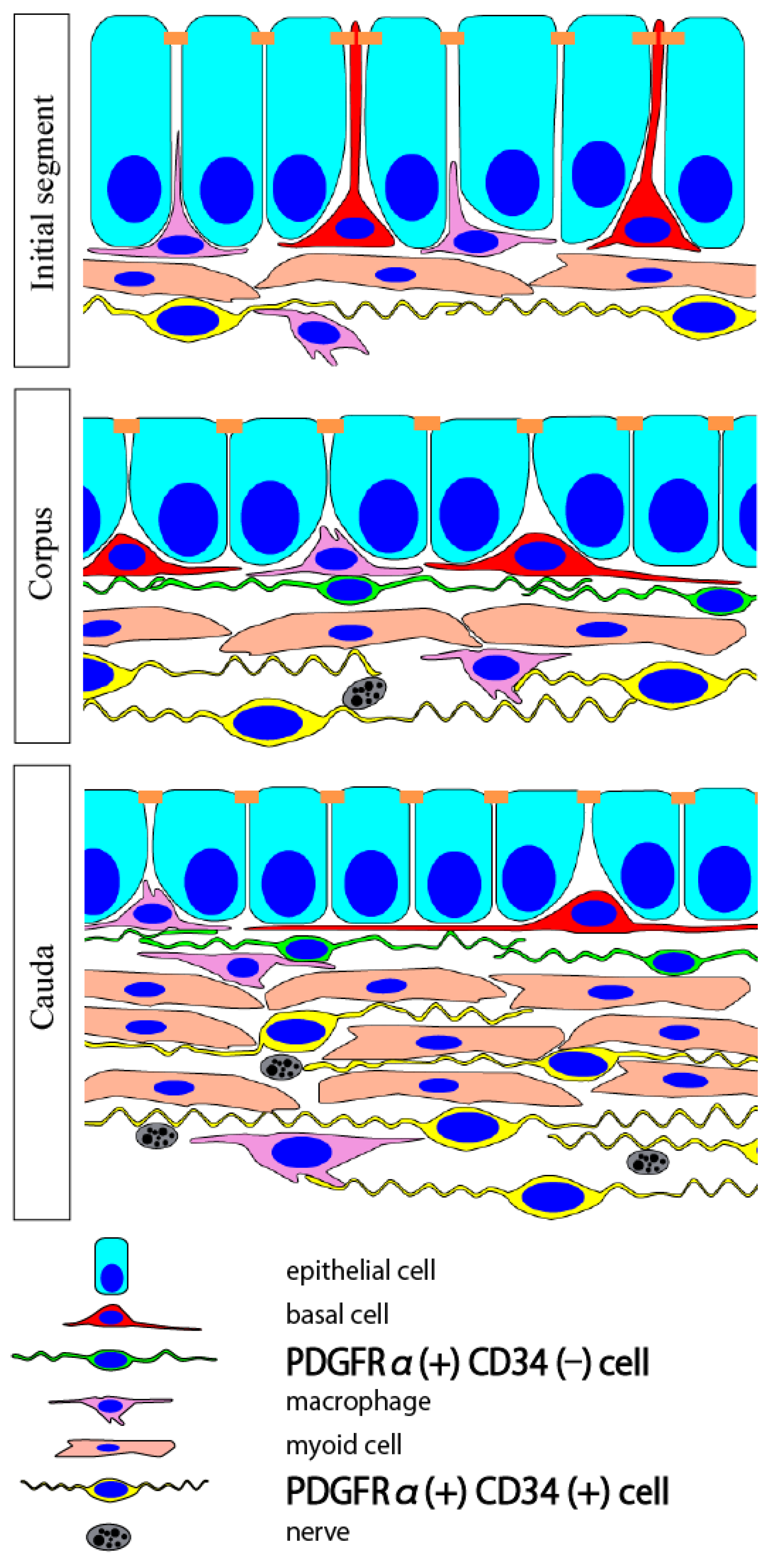

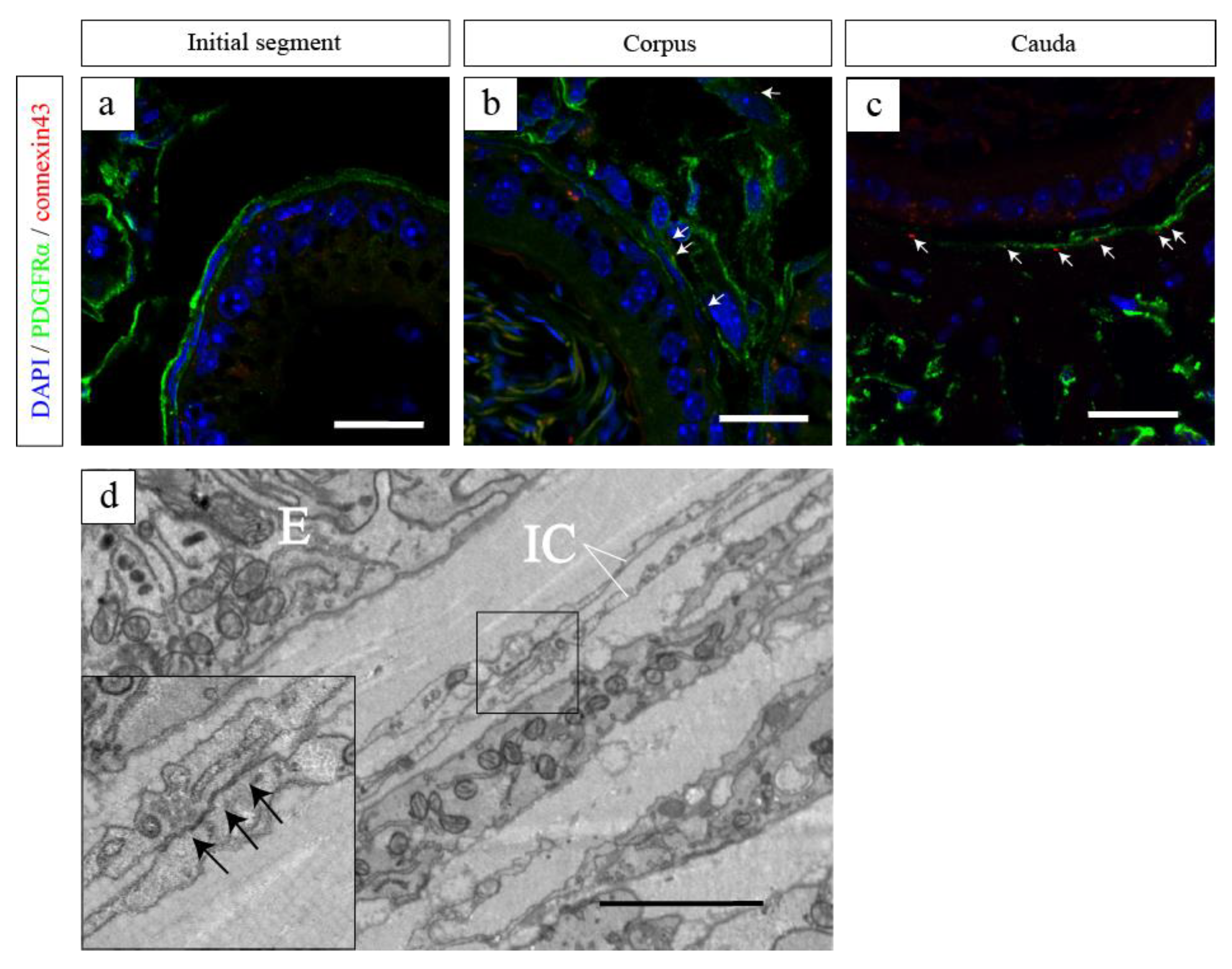
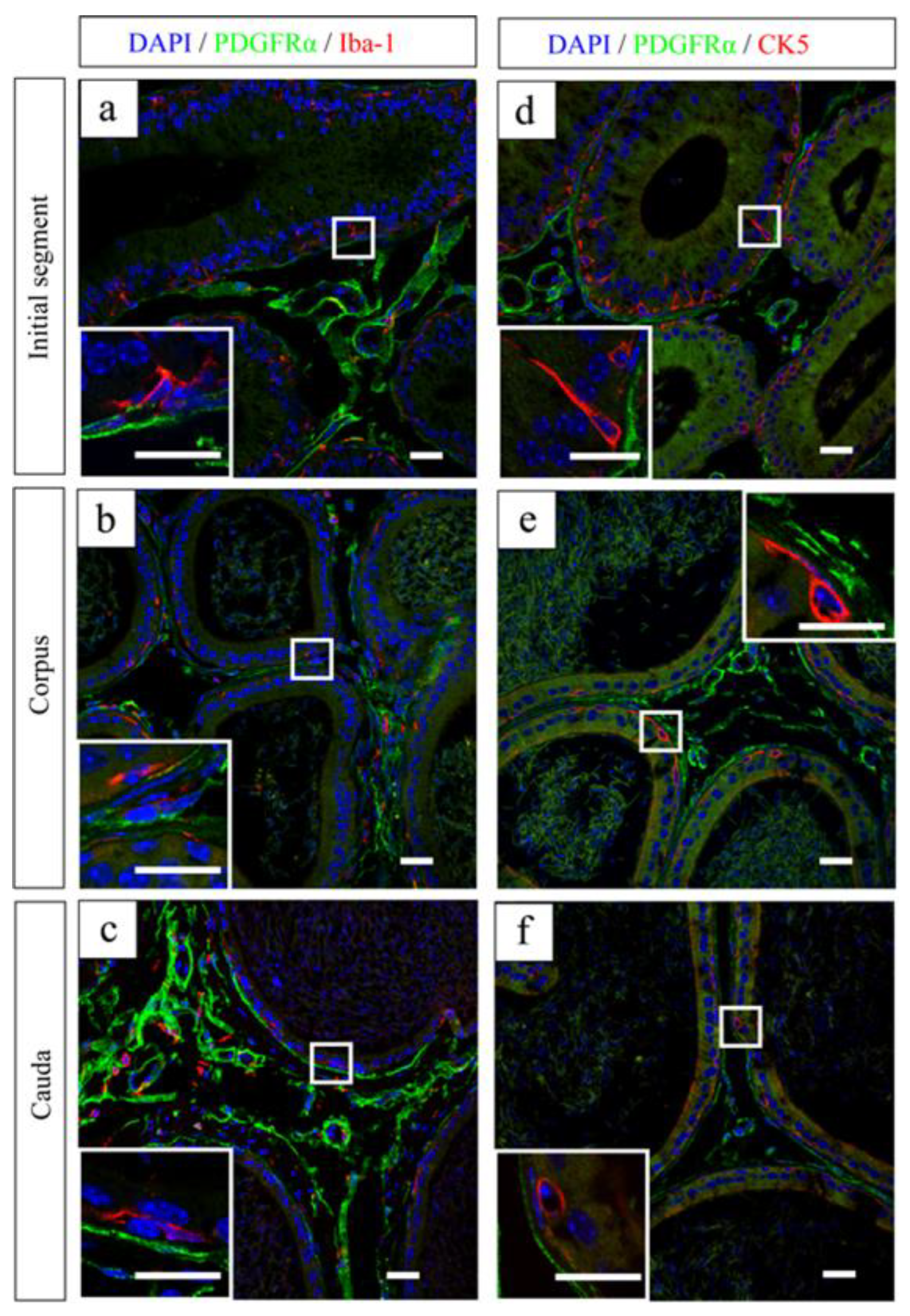
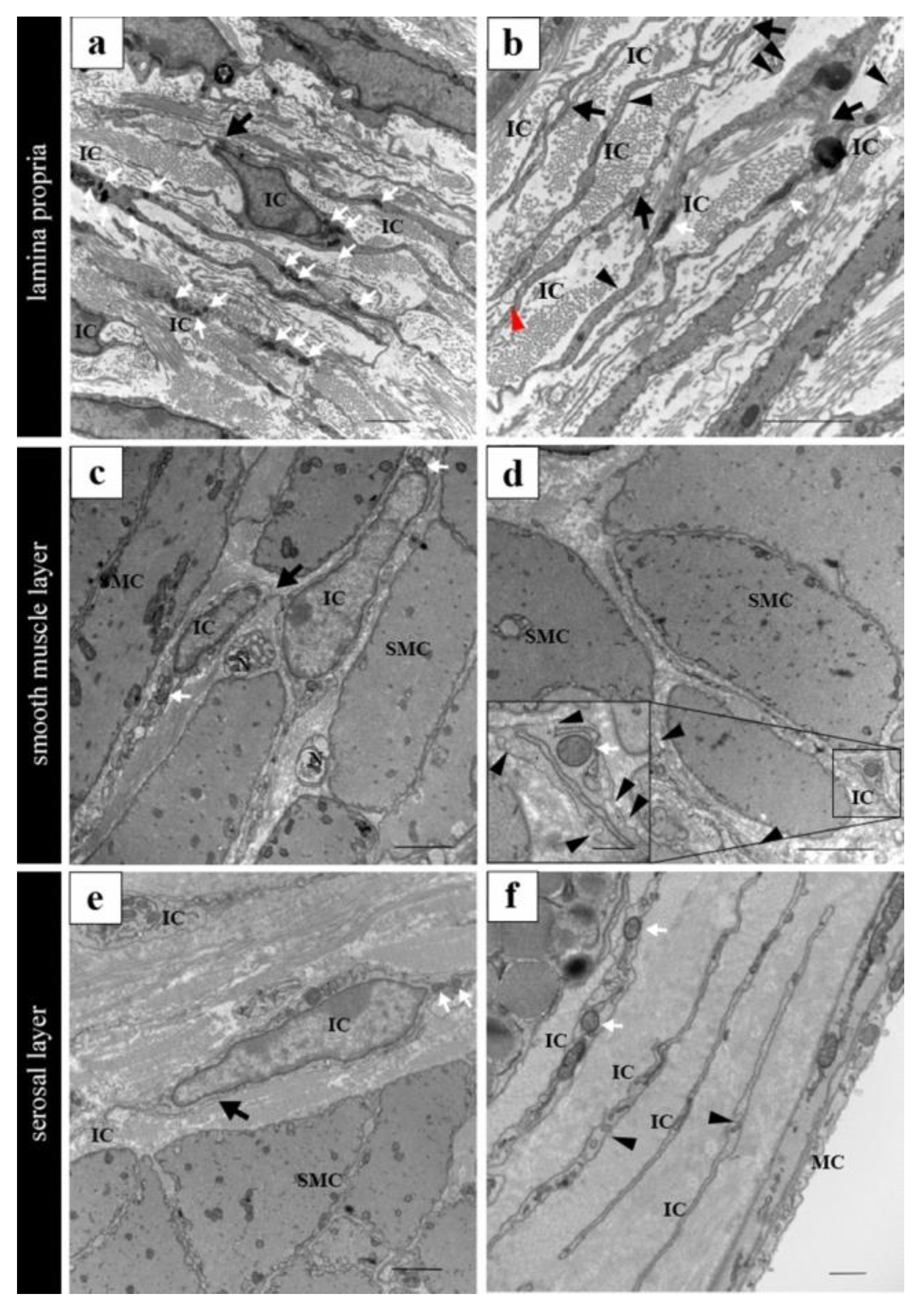
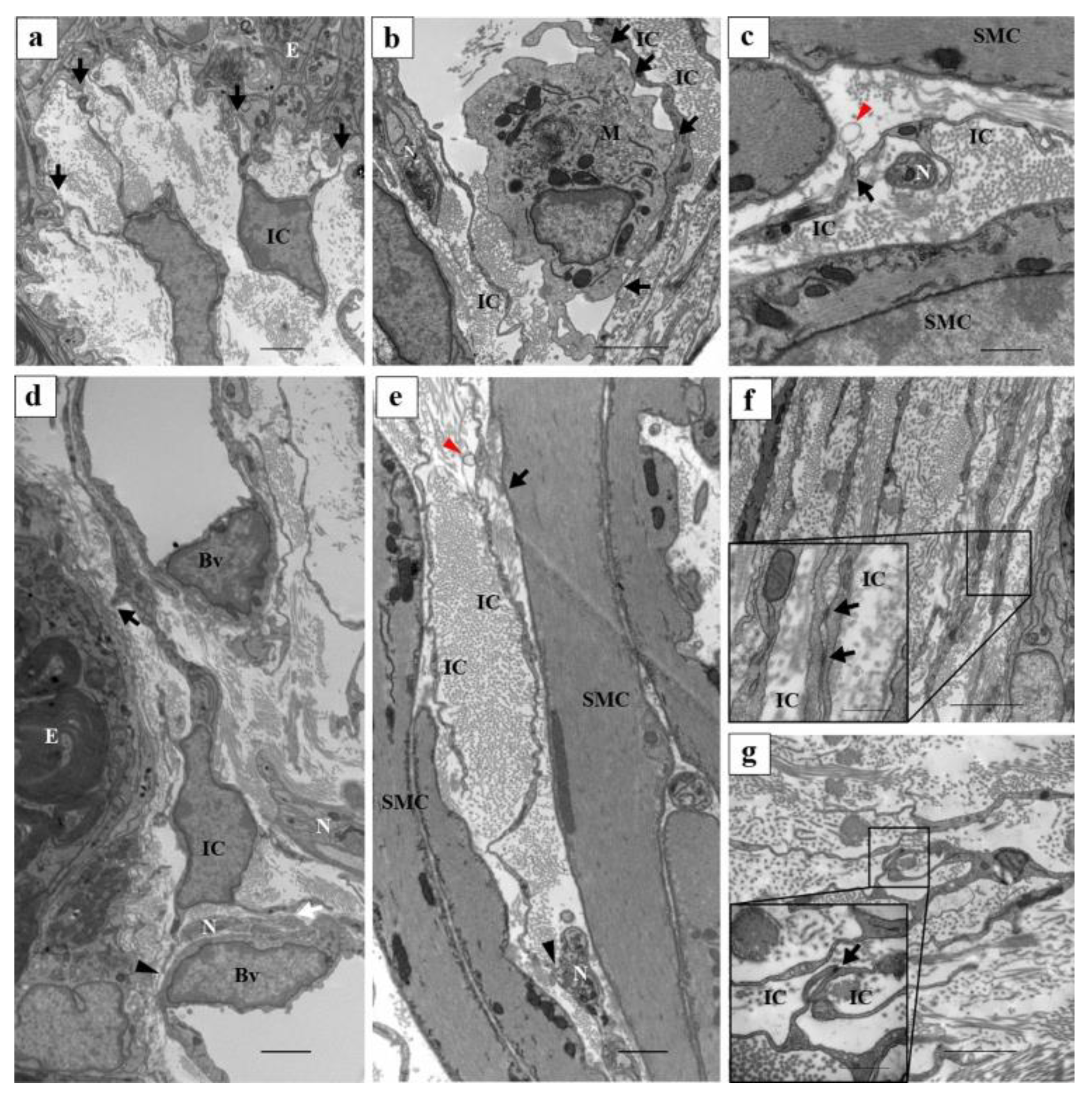


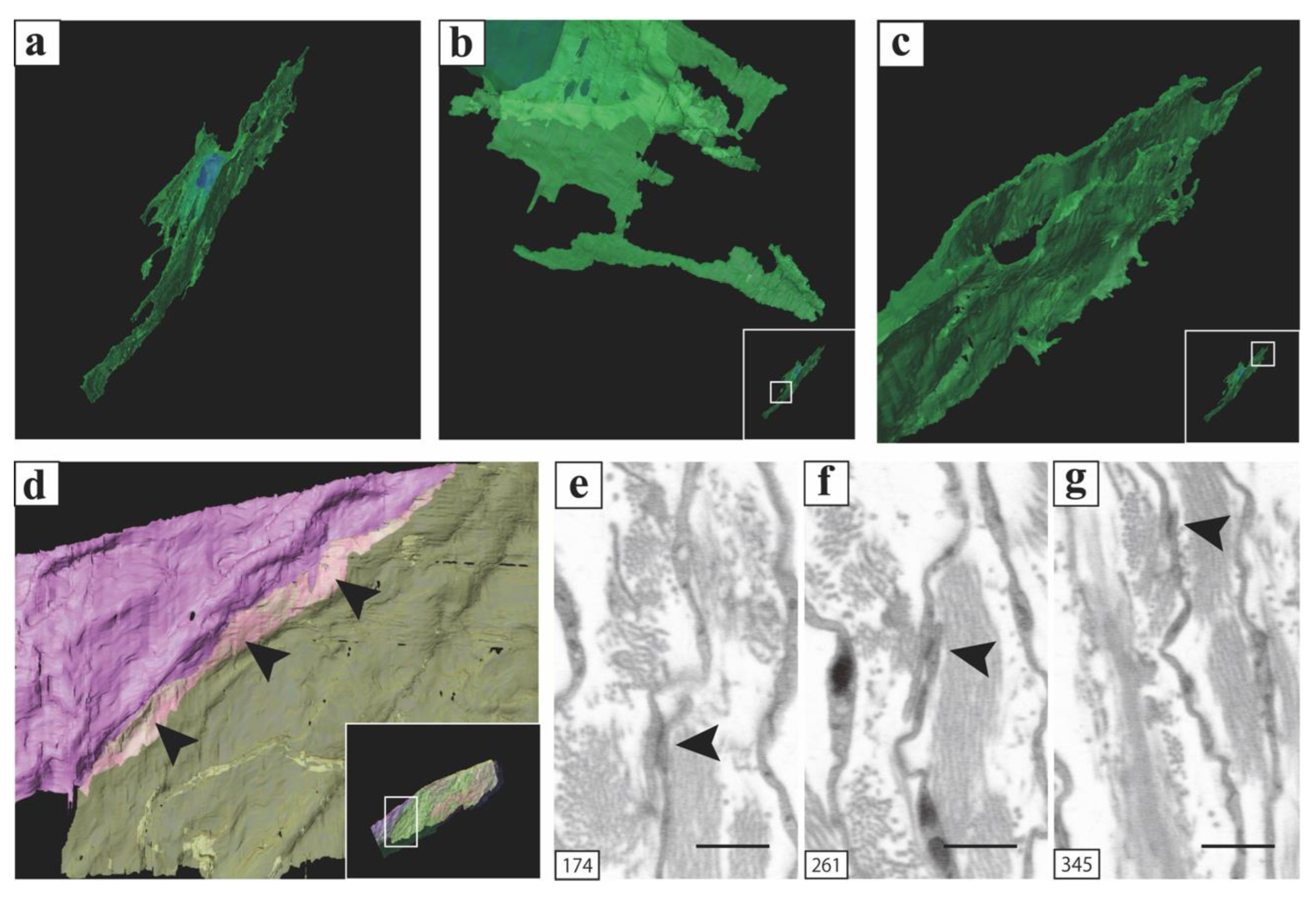
Disclaimer/Publisher’s Note: The statements, opinions and data contained in all publications are solely those of the individual author(s) and contributor(s) and not of MDPI and/or the editor(s). MDPI and/or the editor(s) disclaim responsibility for any injury to people or property resulting from any ideas, methods, instructions or products referred to in the content. |
© 2024 by the authors. Licensee MDPI, Basel, Switzerland. This article is an open access article distributed under the terms and conditions of the Creative Commons Attribution (CC BY) license (https://creativecommons.org/licenses/by/4.0/).
Share and Cite
Hiroshige, T.; Uemura, K.-I.; Nakamura, K.-I.; Igawa, T. Insights on Platelet-Derived Growth Factor Receptor α-Positive Interstitial Cells in the Male Reproductive Tract. Int. J. Mol. Sci. 2024, 25, 4128. https://doi.org/10.3390/ijms25074128
Hiroshige T, Uemura K-I, Nakamura K-I, Igawa T. Insights on Platelet-Derived Growth Factor Receptor α-Positive Interstitial Cells in the Male Reproductive Tract. International Journal of Molecular Sciences. 2024; 25(7):4128. https://doi.org/10.3390/ijms25074128
Chicago/Turabian StyleHiroshige, Tasuku, Kei-Ichiro Uemura, Kei-Ichiro Nakamura, and Tsukasa Igawa. 2024. "Insights on Platelet-Derived Growth Factor Receptor α-Positive Interstitial Cells in the Male Reproductive Tract" International Journal of Molecular Sciences 25, no. 7: 4128. https://doi.org/10.3390/ijms25074128





